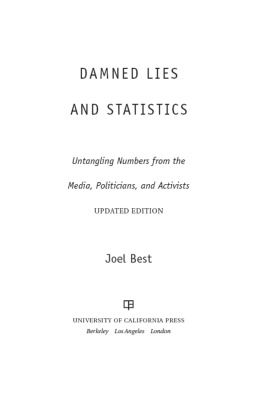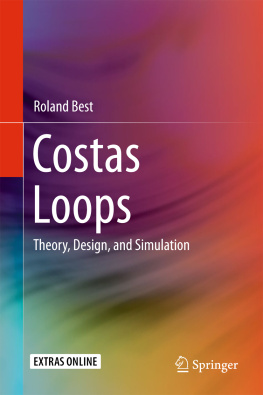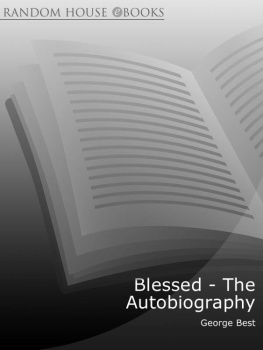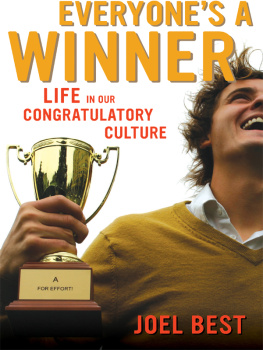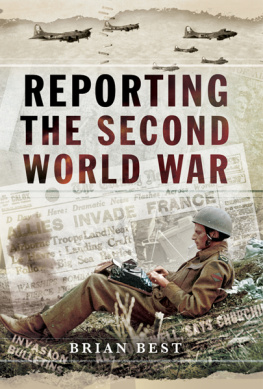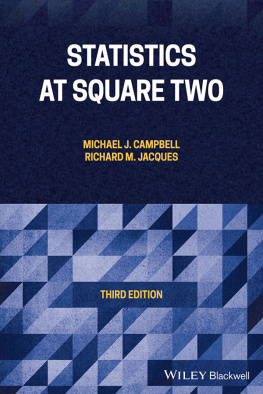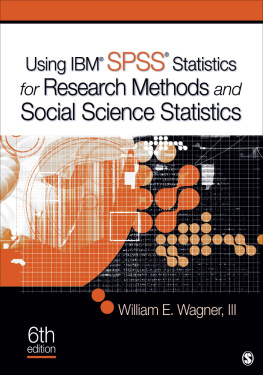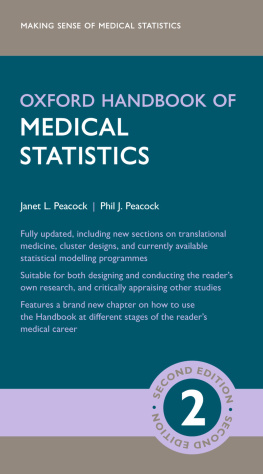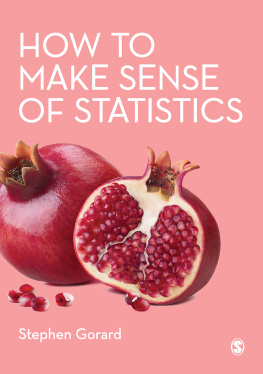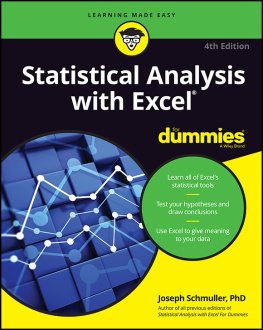
PRAISE FOR THE PREVIOUS EDITION OF DAMNED LIES AND STATISTICS:
Definitely a must for politicians, activists, and others who generate or use statistics, but especially for those who want to think for themselves rather than take as gospel every statistic presented to them.
New Scientist
Theres a 73 percent chance that the University of Delaware prof has got our number.
San Diego Union-Tribune
Best is our leading authority on social problems today. His detective work in exposing the spurious use of statistics is essential to constructive social science. No one who speaks for the public welfare can ignore his powerful work.
Jonathan B. Imber, Editor-in-Chief, Society
Joel Best is at it again. In Damned Lies and Statistics, he shows how statistics are manipulated, mismanaged, misrepresented, and massaged by officials and other powerful groups to promote their agendas. He is a master at examining taken-for-granted facts and debunking them through careful sociological scrutiny.
Patricia Adler, author of Peer Power
In our era, numbers are as much a staple of political debates as stories. And just as stories so often turn into fables, so Best shows that we often believe the most implausible of numbersto the detriment of us all.
Peter Reuter, coauthor of Drug War Heresies: Learning from Other Vices, Times and Places
Whether we like them or not, we have to live with statistics, and Damned Lies and Statistics offers a useful guide for engaging with their troublesome world. Despite the temptation to be cynical, the author of this timely and excellent work cautions the reader against reacting in such a way to statistics. What we are offered is an approach that helps us to work out the real story behind those numbers.
The Independent
Damned Lies and Statistics is highly entertaining as well as instructive. Bests book shows how some of those big numbers indicating big social problems were created in the first place and instructs the reader (and reporter) how to be on guard against such gross manipulation. And it doesnt take an understanding of advanced mathematics to do so thanks to this book, which ought to be required reading in every newsroom in the country.
Washington Times
The narrative flows easily, and all the points are driven home with engaging examples from real life. I found Bests book a delight. Always engaging, it is accessible to a lay reader, yet will reward the expert; the examples it gives could enrich both a primary schoolroom and a university lecture hall.
Nature
[An] absolutely fascinating and sobering quest into the fantastic differences between the world as it is and the world as it is portrayed in the statistics the media use. This book is simply a must.
Nachman Ben-Yehuda, author of The Masada Myth
DAMNED LIES AND STATISTICS
University of California Press, one of the most distinguished university presses in the United States, enriches lives around the world by advancing scholarship in the humanities, social sciences, and natural sciences. Its activities are supported by the UC Press Foundation and by philanthropic contributions from individuals and institutions. For more information, visit www.ucpress.edu.
University of California Press
Berkeley and Los Angeles, California
University of California Press, Ltd.
London, England
2001, 2012 by
The Regents of the University of California
ISBN 978-0-520-27470-9
LIBRARY OF CONGRESS
CATALOGING-IN-PUBLICATION DATA
Best, Joel.
Damned lies and statistics : untangling numbers from the media, politicians, and activists / Joel Best.
p. cm.
Includes bibliographical references and index.
ISBN 978-0-520-21978-6 (cloth : alk. paper)
1. SociologyStatistical methods. 2. Social problemsStatistical methods. 3. Social indicators. I. Title.
HM535.B47 2001
303.3'8dc21 00-064910
Printed in the United States of America
18 17 16 15 14 13 12
10 9 8 7 6 5 4 3 2 1
In keeping with a commitment to support environmentally responsible and sustainable printing practices, UC Press has printed this book on Rolland Enviro100, a 100% post-consumer fiber paper that is FSC certified, deinked, processed chlorine-free, and manufactured with renewable biogas energy. It is acid-free and EcoLogo certified.
For Kathe Lowney
ACKNOWLEDGMENTS
Philip Jenkins and I originally planned to write this book together. Although Philip had too many other projects to find the time to work on this one as well, he generously suggested several examples, pointed me toward sources, and commented on drafts. I also benefited from valuable comments by Margaret Andersen, Ronet Bachman, Loy Bilderback, Robert Broadhead, James A. Holstein, Timothy Kubal, Donileen R. Loseke, David F. Luckenbill, and Tracy M. Thibodeau. University of Delaware honors students Tammy Ader, Brian Arban, Andrew Devereaux, Thomas Madura, Karen McCready, Jacquelynn Nicnick, Meghan Shaw, Barbara Sweeney, Denise Weaver, Kelly Wesstrom, and Melissa Zwickel read the entire manuscript and gave me valuable feedback. Writing a critique of common errors in reasoning is a tricky business: it invites readers to find the mistakes in these pages. It would be nice to be able to blame scapegoats but, alas, the friends who commented on the manuscript gave me good advicealthough I didnt always take it. The flaws are mine.
PREFACE TO THE UPDATED EDITION
Darrell Huffs little book, How to Lie with Statistics, made a bigger impression on me than anything else I read during my first year in college. It wasnt even assigned reading; the TA in my statistics lab mentioned it in passing, the title struck me as amusing, and I borrowed the book from the campus library. It was a great read: by cataloging basic forms of statistical malpractice, Huff gave me a set of critical tools I could apply when reading news stories.
As the years went by, it became clear to me that the errors Huff had exposed remained alive and well. Sometime in the early 1990s, I reread How to Lie with Statistics. This time, I was less impressed. While Huff still offered a terrific introduction to the topic, I realized that hed barely scratched the surface. I started thinking about writing a book of my own, one that provided a more comprehensive, more sociological approach. Damned Lies and Statistics was the result.
Sociology professors get used to writing for other sociologists. The chief pleasure of having written this book has been discovering the broad range of people who have read it and told me what they thoughtprofessors and students, of course, but all sorts of folks outside academiajournalists, activists, math teachers, judges, doctors, even a mom whod assigned it to her homeschooled child. Lots of people have found the topic interesting, and I continue to get email messages drawing my attention to particularly dubious numbers.
And there is no shortage of questionable numbers. This version of the book contains a new afterword that tries to explain why, even if we all agree that people ought to think more critically about the figures that inform our public debates, we seem unable to drive bad statistics out of the marketplace of ideas.
NOTES
Darrell Huff, How to Lie with Statistics (New York: Norton, 1954). For a symposium on Huffs book, see the special section How to Lie with Statistics Turns Fifty, in Statistical Science 20 (2005): 20560.
INTRODUCTION
The Worst Social Statistic Ever
The dissertation prospectus began by quoting a statistica grabber meant to capture the readers attention. (A dissertation prospectus is a lengthy proposal for a research project leading to a Ph.D. degreethe ultimate credential for a would-be scholar.) The Graduate Student who wrote this prospectus undoubtedly wanted to seem scholarly to the professors who would read it; they would be supervising the proposed research. And what could be more scholarly than a nice, authoritative statistic, quoted from a professional journal in the Students field?
Next page
